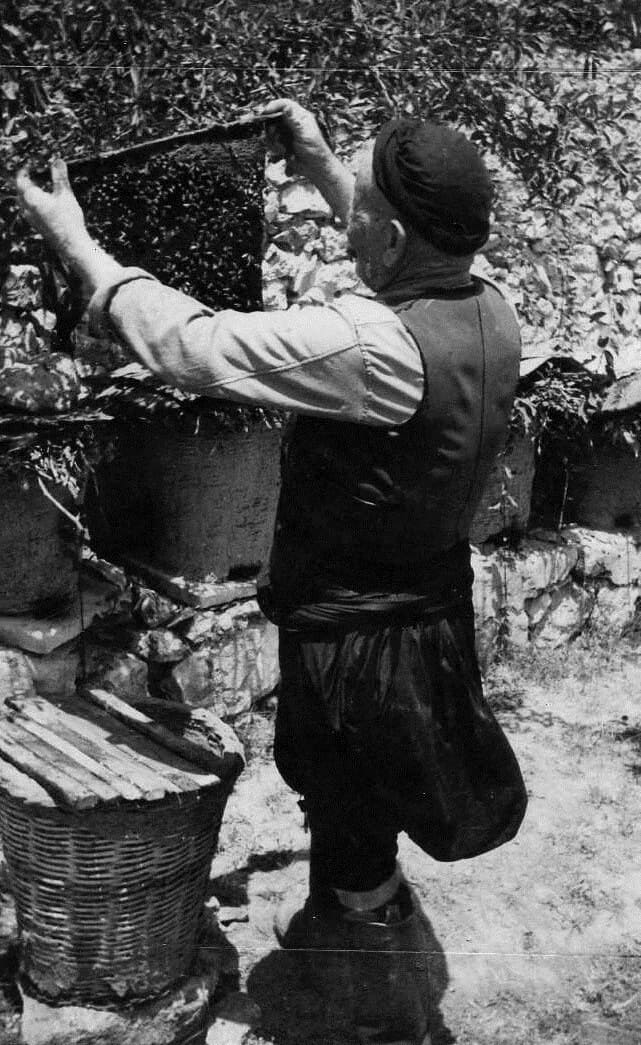Traditional beekeeping with movable-comb hives
(urgent preservation & safeguard)
Crete

Α beekeeper examines a honeycomb from a Cretan open-at-the-top-and-bottom movable-comb basket hive, 1938
Photo: Penelope (Popi) Papadopoulou, Institute of Agricultural Sciences Archive, Greece
With financial support and under the auspices

About the initiative
Overview
BEELOSOPHY documents traditional beekeeping with movable-comb hives, with the assistance of some of its last living bearers. Special emphasis is put on the upright hives of Crete and Kythera. The initiative includes study visits, collection and production of documentary material, creation of educational and cultural media (videos, recordings, storytelling, photographs, brochure), production and installation of clay hive replicas for educational and cultural purposes, as well as communication, networking, and dissemination activities. The initiative supports modern-day interpretation, protection and safeguard of this cultural heritage, while also highlighting other related cultural elements.
Objectives – Priorities
The action aims to contribute to the preservation and safeguard of the Greek traditional beekeeping method of movable-comb hives. Practitioners in Crete, Kythera, Attica and elsewhere are encouraged to utilise the traditional method to gain stimuli and knowledge, enrich activities related to beekeeping, alternative tourism, educational, cultural and other fields to familiarise the public with tradition and the cultural landscape, and to contribute to the promotion of beekeeping heritage as a factor of sustainable development, cohesion and empowerment of local societies. The results of the action can be incorporated in areas where movable-comb hives have traditionally been used (central/ western Crete, Kythera, Antikythera, eastern Peloponnese, Argosaronic islands, Attica, Kea), without altering the identity of the referred-to regions.
Justification - Significance
Greek traditional beekeeping preserves millennia of local ecological knowledge, fostering biodiversity, resilient livelihoods, and cultural identity, while also offering valuable insights for sustainable development and conservation. It features an impressively large variety of hive types and beekeeping methods, with movable-comb hives being the most important traditional method of beekeeping in Greece. Known since antiquity, these hives had a decisive influence on global beekeeping, as Lorenzo Langstroth in the United States based his understanding of the bee space on them and patented the modern movable-frame hive in 1852, which remains the most widely used hive worldwide. Additionally, variants of the Greek movable-comb hive are now the most widespread type in the developing world.
The preservation of this traditional knowledge, which is currently at immediate risk of disappearing, is not only a matter of cultural heritage; it provides valuable information for sustainable development, biodiversity conservation, ecosystem resilience, and scientific research, connecting tradition with practices that have relevance for modern life and knowledge.
In 2025 the element "Βeekeeping tradition of Kythera" was inscribed on the Hellenic Inventory of Intangible Cultural Heritage.

Apiary with clay movable-comb hives near Sphakia, Crete, ca. 1921
Photo: ETH Library Zurich, Image Archive / Hs_1360-1491

Apiary with open-at-the-top-and-bottom basket hives, Cambani (Acrotiri), Chania, Crete, 1939
Photo: Penelope (Popi) Papadopoulou, Institute of Agricultural Sciences Archive, Athens, Greece
Auspices





Support the Initiative
Become part of a hive of hope for bees, nature, and our culture. Together, we preserve biodiversity, showcase our heritage, and inspire communities.
Thank you!
